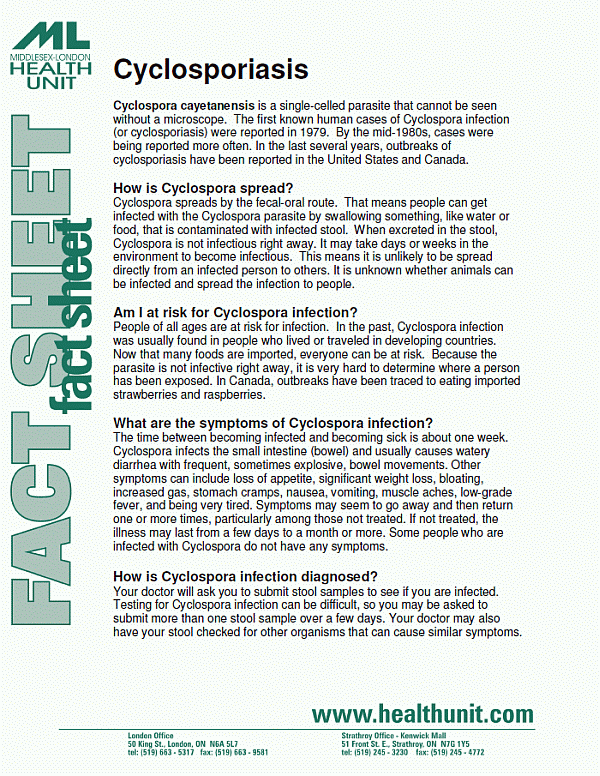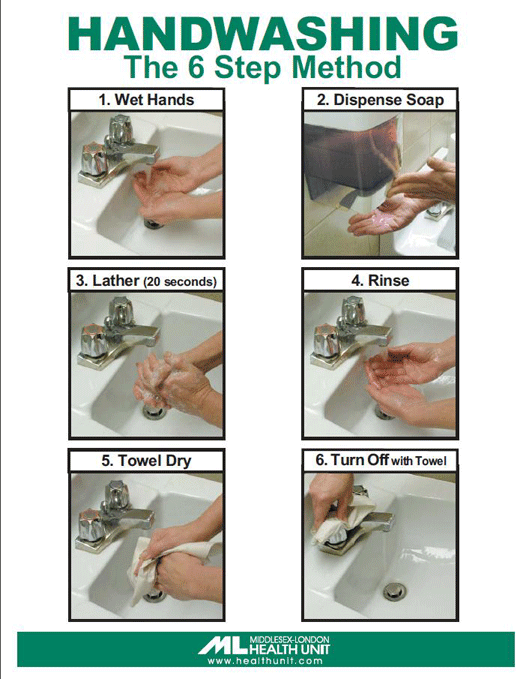Contact Us
For more information, please contact the Infectious Disease Control Team:
- 519-663-5317 Ext. 2330
What is Cyclospora (Cyclosporiasis)? Cyclospora cayetanensis is a single-celled parasite that cannot be seen without a microscope. Cyclospora infects the small intestine (bowel) and usually causes watery diarrhea with frequent, sometimes explosive, bowel movements. The first known human cases of Cyclospora infection (or cyclosporiasis) were reported in 1979. By the mid-1980s, cases were being reported more often. In the last several years, outbreaks of cyclosporiasis have been reported in the United States and Canada.
 Cyclosporiasis Fact Sheet (PDF 76KB)
Cyclosporiasis Fact Sheet (PDF 76KB)For more information, please contact the Infectious Disease Control Team:
Cyclospora spreads by the fecal-oral route. That means people can get infected with the Cyclospora parasite by swallowing something, like water or food, that is contaminated with infected stool. When excreted in the stool, Cyclospora is not infectious right away. It may take days or weeks in the environment to become infectious. This means it is unlikely to be spread directly from an infected person to others. It is unknown whether animals can be infected and spread the infection to people.
People of all ages are at risk for infection. In the past, Cyclospora infection was usually found in people who lived or traveled in developing countries. Now that many foods are imported, everyone can be at risk. Because the parasite is not infective right away, it is very hard to determine where a person has been exposed. In Canada, outbreaks have been traced to eating imported strawberries and raspberries.
The time between becoming infected and becoming sick is about one week. Cyclospora infects the small intestine (bowel) and usually causes:
Symptoms may seem to go away and then return one or more times, particularly among those not treated. If not treated, the illness may last from a few days to a month or more. Some people who are infected with Cyclospora do not have any symptoms.
Your doctor will ask you to submit stool samples to see if you are infected. Testing for Cyclospora infection can be difficult, so you may be asked to submit more than one stool sample over a few days. Your doctor may also have your stool checked for other organisms that can cause similar symptoms.
The recommended treatment for Cyclospora infection is trimethoprim-sulfamethoxazole. Your doctor may prescribe this. People who have diarrhea should rest and drink plenty of fluids.
Food that is contaminated with cyclospora will not look or smell bad. Through hand washing and safe food handling are the best prevention.
Wash your hands with soap and water after using the toilet, changing diapers and before preparing food and after touching raw foods.
The six steps to good hand washing are:
 The 6 Step Method of Handwashing (PDF 96KB)
The 6 Step Method of Handwashing (PDF 96KB)When travelling, camping or hiking, boil water for at least one minute, or drink only canned or bottled carbonated beverages. This parasite is not killed by low doses of chlorine or iodine. Remember to also boil water that is to be used for brushing teeth. Ice cubes made from contaminated water may also carry the parasite.
If you are sick with diarrhea, see your doctor and avoid handling or preparing food for others.